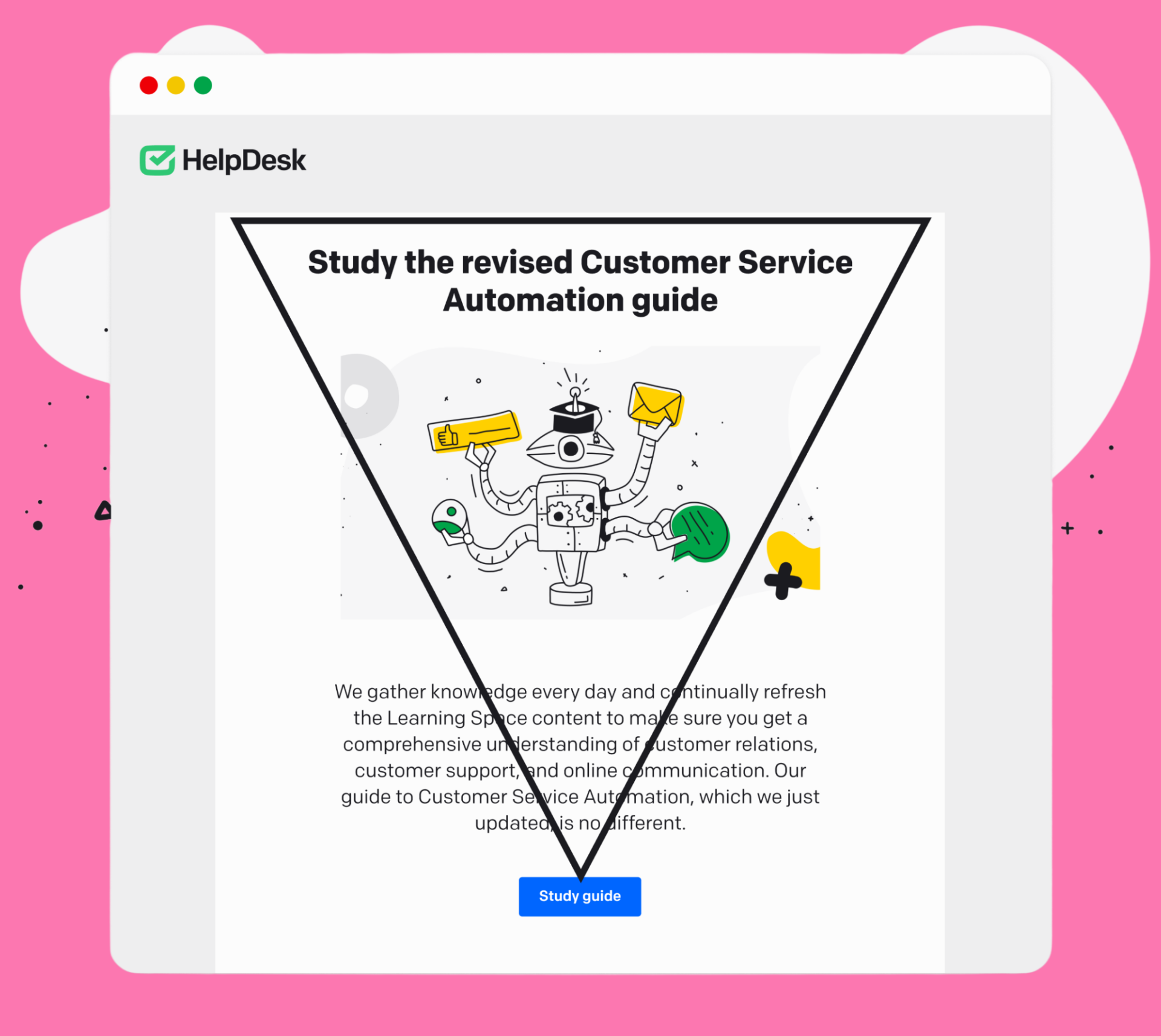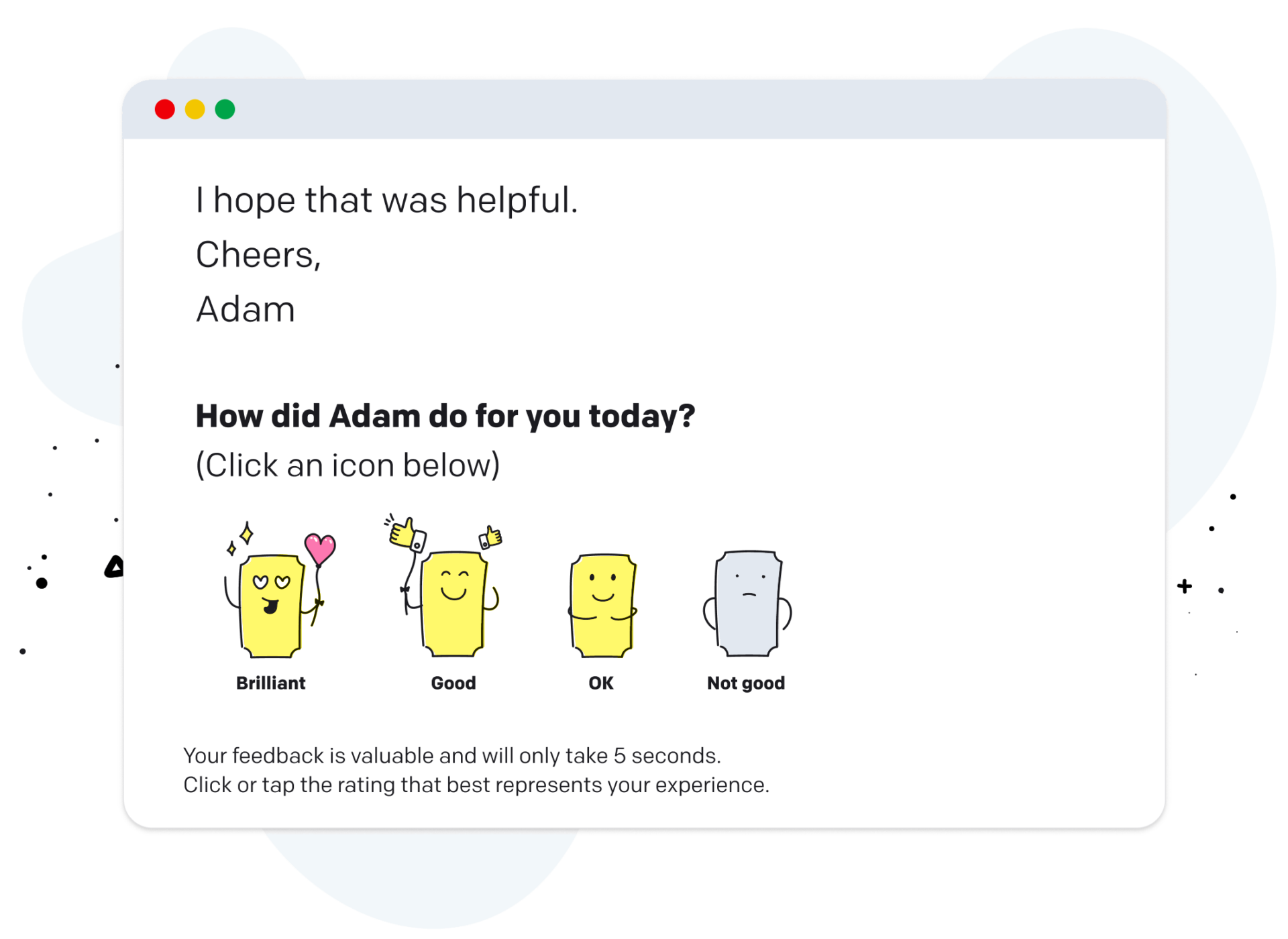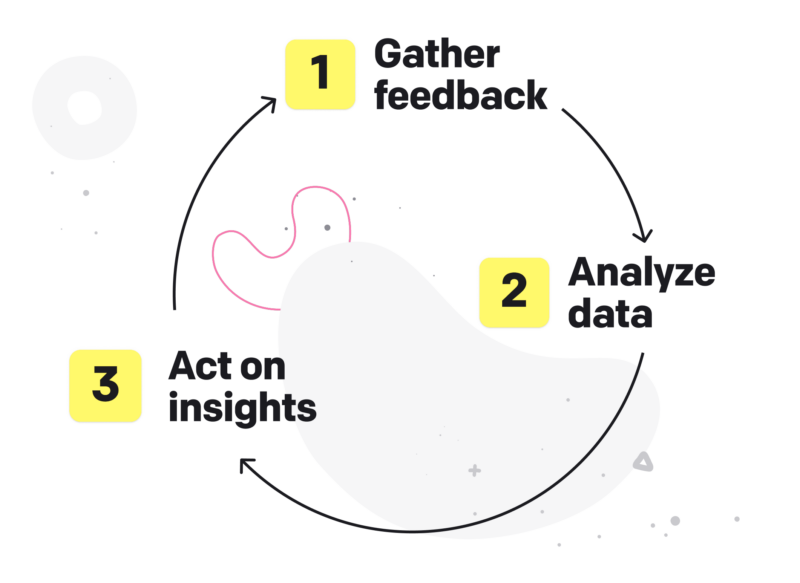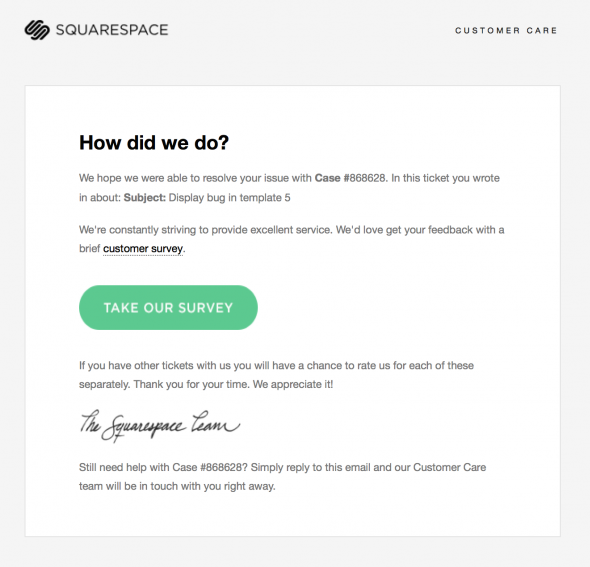According to the research conducted by Esteban Kolsky, 13% of dissatisfied customers will share their complaints with 15 or more people from their closest circle. But only 1 in 25 unhappy customers will complain directly to you. This makes it all the more important to listen when customers give you feedback, and use it to improve your customer service.
In this article, I’ll focus on the two most popular channels for generating customer feedback: chat and email (or ticket). Each plays an essential role in customer-centricity.
Cut out the guesswork when improving customer service operations. Know exactly what areas need attention through customer feedback and first-hand experience. Learn the pros and cons of asynchronous and synchronous feedback.
Why should you collect customer feedback?
Consider these questions:
- Are you confident that you’re friendly and considerate enough to your customers?
- Do you think that you’re responding on time to your recipient?
- How can you be sure you’re providing the support your customers require?
- Do you know how to improve the customer experience?
Regularly collecting and analyzing customer feedback will help you answer these questions. It’s time for a moment of truth: Are you only hearing or genuinely listening to your customer?
96% of consumers confirm that the quality of support affects their customer loyalty. I can judge the same from the experience of my fellow support heroes: The customer journey is defined by the quality of support provided.
Of course, providing support can take different courses. But, even if you make a mistake while providing help, worry not! If your company’s daily customer service is above average, 78% of customers will do business with you again, even after a slip-up.
Customers are open to giving you room for improvement, so take this chance to turn things around.
How to collect asynchronous customer feedback
The first thing that comes to mind when thinking about asynchronous communication is email. You can use this channel to gather customer feedback through surveys with open-ended or closed-ended questions, short questionnaires with ratings from 1-5, as well as sentiment analysis done through polarity categories such as “very positive,” “positive,” “neutral,” “negative,” or “very negative.” The form of an email survey largely depends on your goals for customer feedback.
When designing an email survey, focus on creating a well-thought-out message and a meaningful call-to-action button. Keeping your customer feedback request to the point is a way to hold the recipient’s attention on the message and the action you want them to take, such as clicking the button and taking the survey.
For this reason, limit all distractions and don’t add unnecessary images or headlines. The support agents on my team suggest using an inverted pyramid model to create the perfect customer feedback email. If the results of your feedback requests have been performing poorly so far, maybe this is your way to go.

Finally, be super clear about why you want feedback from your recipient. Tell them why it’s important to you and what you intend to do with it in the next step. For example, you could say that the customer feedback will help you serve them better in the future, or that you’ll make improvements to your offerings to make them a better fit.
Now, look at the following example from Squarespace. Notice how this message clarifies expectations for the recipient. The Squarespace team wants them to read the self-explanatory headline first and then click the “Take Our Survey” button to collect customer feedback. If the recipient clicks on the button, it’ll take them to a survey view with questions.
Data shows that the average response rate to email surveys is about 30%. On that account, survey questions must be short and to the point. If you ask more of them, you’ll face slower response times or no response at all. Make your email crisp and clear so the recipient can easily grasp it.
Regarding questions, there are two types that you can use while creating your email survey: open-ended and closed-ended.
The open-ended questions in email surveys require more than one-word answers and can be in the form of a list or several sentences/paragraphs. Due to their form, these questions require considerable intellectual effort on the part of the recipient. Here’s an example of an open-ended question: Have you experienced good customer support?
On the other hand, closed-ended questions can be answered with just one word or a short, specific statement. They may involve choosing “Yes” or “No,” or selecting an answer from a set of possible choices, such as a scale of 1-5 or the options “A, B, C, or all of the above.” Here’s an example of a closed-ended question: Did you like our customer support?
Use thoughtful questions to steer your customers in the right direction depending on the types of customer feedback you want.
Another type of email survey is the one in your signature. With a short and simple feedback survey in your email signature, you can create a steady stream of customer feedback — surveys are always in your message, ready to be completed. In addition, you can quickly gauge the sentiment around a particular type of survey and draw conclusions. By organizing email communication using a ticketing system, you can see exactly who provided feedback, even if they did so through your signature.
- How would you rate my assistance? If you’d like to know if you met the customer’s expectations.
- What do you think of our products/services? If you’d like to know the attitude towards your offer.
- How would you rate our brand? If you’d like to know the customer’s attitude toward your brand.
- Are you familiar with product X? If you’d like to see if a marketing, promotional, or sales campaign is effective.

Give loyal customers the opportunity to provide additional feedback to make your email surveys a big success. One “smiley face” won’t tell you much about what specifically your customers value in your support. Ask for additional feedback to get more details. This also shows how much you appreciate your customers, and that their opinions matter.
So, if a customer clicks on “OK” while evaluating your support actions, the next question in the follow-up email might be: “Can you say a little more about how I can improve my work?” It can do wonders!
The pros of asynchronous customer feedback collection
1. Traditional and widespread tool
According to Edison Mail, more than half of Gen Z (53%), Millennials (58%), and Generation X (55%) rely on their email inboxes for business correspondence. The conclusion is that email is a traditional tool familiar to many generations of customers.
What’s even better is that email can be viewed from multiple browsers and devices, especially mobile. Data shows that 81% of people prefer to open emails on their smartphones, while 21% open them on their tablets. The customers can access the feedback request messages straight from their inbox or email provider’s solution, saving time and going at their own pace when providing relevant customer feedback to support agents.
2. Extensive customization options
You can freely customize your emails, including customer feedback requests, and use popular options for formatting text, including images, and adding all sizes and types of attachments. You can even add videos and use your voice and emotions to better explain your goals for collecting customer feedback.
Then, if you have a ticketing system, your email can become a ticket, and you can easily manage its further progress along the customer support funnel. Working with tickets as part of asynchronous communication is definitely a calmer way to work and gather customer feedback.
3. Feedback flows can be automated
Integrating your email with an email automation tool can automate the feedback collection process and create a pipeline for sending and collecting customer feedback without your direct involvement.
Customers can share their email addresses with you across multiple channels, such as forms, sign-ups for free trials, ads, or chats, and you can use them all in your customer feedback strategy. Also, you can decide the frequency and the scale when it comes to sending feedback emails. You have all the control but don’t have to lift a finger to get things done. You can also set up DMARC and follow other email security practices to ensure that survey emails actually reach the customer’s inboxes.
4. The conversation is always open
In the case of live chat, if a customer remains inactive for a long time or their problem has been solved, the chat closes and often suggests the option of leaving feedback. Customers may be concerned that voicing an opinion in the chat will re-initiate a conversation, yet they no longer have a problem to solve.
That leaves email, which keeps the conversation and customer feedback funnel open. Asynchronous communication allows customers to keep track of messages and give appropriate feedback at any time.

The cons of asynchronous customer feedback collection
1. Different customer feedback survey forms make the analysis difficult
Email feedback requests can come in all shapes and sizes. This is helpful because you can go creative and use the latest methodologies to get customer feedback. But on the other hand, the more qualitative and quantitative research methods you develop, the harder it is to analyze and combine the data. For example, you need to create separate reports so that the results are sound.
Additionally, your customer feedback form can be sent from a no-reply email address, making it impossible for the customer to write back if they have any concerns. The conversation flattens out, making you less able to understand what the customer liked and disliked.
2. Customers aren’t sure they’re dealing with a human
Customers have no assurance their feedback will go to a real person and have even less faith that their comments will even make a difference. Added to this is the ever-present desensitization to customer feedback emails, caused mainly by spam. Because of this, customers are economical with words and don’t fully express their needs in surveys.
On top of that, email, as a traditional method of collecting customer feedback, creates a lag between the customer’s experience and the time the customer was asked to provide feedback. So, when a person receives a survey email a few days after making a purchase, the chances of getting any response are slim.
3. Time-consuming review of the entire email thread
When you’re a support hero, reviewing and reading the entire email conversation thread is labor-intensive — you need to know the customer’s backstory when you receive negative or positive feedback via email. It takes time to re-identify and empathize with the customer and thoroughly understand the opinion left.
How to collect synchronous customer feedback
If a genuine interpersonal relationship is desired, communication via chat may be the right solution. Chats are considered real-time communication with a clear beginning and end. It’s usually characterized by quicker response times because you know the person on the other side is waiting for your reaction.
You can install a relevant live chat app on your existing websites so that your customer success team can talk to visitors about their experience. Real-time conversations allow you to send a post-chat survey and ask organic follow-up questions immediately after an interaction. You can then record customer feedback and use the data to improve your team and customer service processes.
Depending on the chat solution and the analytics data you want to collect, chat surveys can be simple and have basic research options, such as hitting the like/dislike button or rating the session on a scale of 5. Alternatively, they can be detailed and ask the customer to fill out a short questionnaire to describe their experience.

Now, imagine you’ve had a great conversation with a customer. You helped them and ended the conversation with the words: “Please give me feedback” or “Please rate me.”
That doesn’t sound natural at all. More like a mandatory closing line according to company policy – pretty harsh. Asking for feedback should be consistent with your communication style and tone. Try questions like the one below to increase the chance of collecting customer feedback:
- How satisfied are you with my assistance?
- Did I do a good job supporting you?
- Are you satisfied with my support?
- How did I do? Please feel free to rate my assistance.
- How am I doing?
- How was your conversation with me?
- Did I make your day?
See? You can still meet the company’s goals for customer feedback, but you can make it friendlier.
Collecting data through chat conversations can be a starting point to fill in the gaps and grow as a professional. You can easily analyze chat transcriptions, ratings, customer wording, or other comments to evaluate your work.
The pros of synchronous customer feedback collection
1. An easy way to catch and keep attention
One interactive and feature-rich chat window can make all the difference. Depending on the chat solution, you can grab the customer’s attention with various tricks. Chats can be customized with add-ons and other tools to make the conversation more appealing. You can also cheer up your chat with GIFs and emojis. It’s all up to you how you lead the conversation.
The best part when it comes to chatting is being able to see if the customer has read your message. If there’s no response to your request for feedback, you may want to reflect on the timing and content of the message because there is a clear signal something should change.
When the customer has ended the chat and left you empty-handed, you can use email as a fallback option. Send a message using the email address that the customer provided to start the chat, follow up, and close the customer feedback loop. Write something like: “We had a nice chat, and I’d appreciate it if you’d rate my support. You can do so here in an email or dropping by the chat.” Don’t forget to underline the possibility of restarting the chat to leave customer feedback.
2. Contextual feedback from customers
When you install chat on your business channels, you can gather customer feedback contextually when customers interact with your landing pages, product categories, or service types.
This option is robust because you can instantly ask about the needs or wants of your visitors. Also, you can address potential issues sooner, such as why a customer left products in their shopping cart, what errors they encountered in the app, or what information they noticed was missing in their journey. You can improve your offerings or the quality of resources available to customers.
3. Real-time motivation for support agents
Additionally, real-time customer feedback can be a powerful and motivating method for you and your teammates. If a satisfied customer leaves a positive review, it can boost your engagement and morale in the here and now.
4. Reciprocity works in your favor
Picture this: You’re already in a chat session with a customer and have built an initial relationship with them. Better yet, you’ve provided the right solution to their issue. Such a customer will be much more likely to give you feedback, not because they’re already engaged and having a great time with you, but because you have been supportive.

Due to the reciprocity principle, the customer will feel committed to giving you positive feedback on your work in exchange for your help. This way, you can definitely increase your response rate and online conversion simply by providing the right solution. Besides, collecting feedback using chats is swift and low-friction, as you can capture customers when they are most eager to provide feedback.
The cons of synchronous customer feedback collection
1. Support priorities change depending on the workload
Support agents often have to weather busy periods and high-pressure shifts.
It’s difficult to make customer feedback important and treat it as a priority when other customers are often the priority after a solution has been reached.
2. Running multiple chats at once is cumbersome
I wrote that a support agent could handle up to 30 chats per day. What if I say that some of these chats need to be handled at the same time? It’s a very tricky situation.
If you have to focus on gathering feedback, you may sacrifice the quality of other conversations.
3. Limited size of sent and received chat files
Chat has a limited scope regarding the type of attachments or their size. Most chat solutions allow attachments up to about 10 MB. For this reason, if you plan to send a video encouraging people to leave feedback, you have to move the conversation to email or create a dedicated feedback ticket.
How to improve customer satisfaction with constant feedback
According to the CFI Group, 36% of customers will share their customer support experience, no matter how good or poor it was. Looping customer feedback helps you to identify gaps in your support performance & processes so you can work on them to create a smoother process.
Only by creating an environment of continuous customer feedback and learning can you increase the productivity and integrity of your support team.

To help you turn customer feedback into ideas, I encourage you to change how you think about collecting and using it. Instead of focusing on what customers tell you they want, for example, “I want to reduce notifications from your app,” ask them and yourself: What problem is the customer trying to solve? What task needs to be accomplished here?
I encourage you to frame each problem as a task, focusing on the triggering event or situation, the motivation and goal, and the intended outcome.

Knowing the source of your customer’s problems will allow you to craft solutions that not only solve their challenges but also help develop your business and processes in the desired direction.
Remember that putting customer feedback into practice is sometimes a complicated process. Given this, not acting upon “actionable” feedback for several months doesn’t mean that it was unnecessary or lost — it’s just not the right time to implement it. Every piece of customer feedback counts!
Now, what exactly can you do with customer feedback as a support agent?
1. Improve or upgrade your offer
With a steady dose of customer feedback, you can pass it on to different departments at your company accordingly. Product, sales, and marketing can all become more customer-centric when they listen to (and properly collect) customer feedback. This may take shape in changing existing offerings, as well as improving them according to customer needs.
You can tweak product catalog descriptions, in-app copy, and other written and graphical content, or you can develop new products, services, features, and so on and make it all a data-driven process. Tap into feedback to sense customer sentiment, prevent customer churn, and increase customer loyalty.
2. Understand your customers and users
Chat and email surveys are great ways to collect customer feedback that will help you understand customer behaviors or habits, segment them into different categories, create detailed profiles, and make sales projections.
Use real-world feedback to understand what your customers value. Measure relevant customer service metrics to build a strong brand with desirable products and services. For example, see past behavior, what they view on your website, and what they click on in your mobile app. You can also display heat maps and click maps to understand their needs better.
Conduct passive and unforced learning from customer responses. Carefully monitor customer wording to assess customer satisfaction, improve customer service, and prevent customer churn. So, when your recipient says they’ll withdraw from using your offering, as a support hero, you can alert the right people and counter the crisis. Understand your mistakes that lead to customer dissatisfaction and give your company a chance to soothe concerns immediately.
3. Get a sense of the agents’ performance and work-related issues
One more benefit of customer feedback is that you can fully understand support agents’ performance and pain points.
It’s integral to identifying weaknesses and building on support agents’ strengths. Support managers should collect customer feedback and include it in coaching sessions and mentoring hours to address information or skill gaps of underperformers and level the playing field.
You can smartly improve your customer support team processes to make their work more aligned with reality and enjoyable. Frequently ask agents about their job satisfaction and self-esteem so that their talents and skills remain available to customers. Review customer feedback together to empower your support team and prepare for either satisfied or angry customers who may stand in their way.

4. Refine your internal and external resources
Customers often spot bugs or out-of-date information.
When a customer, for example, sees outdated screenshots describing the use of your app, they’ll report it to you because they simply can’t figure it out. This is an opportunity to improve your assets and, in turn, your customer journey.
Customer feedback leads to many enhancements in your internal and external resources. Feel free to refine help center articles, pricing pages, product descriptions, and other resources publicly available to customers.
5. Build the authority of the support team
When you’re a support hero working on the first or second line of support, you represent the customer’s perspective to other employees and stakeholders. Voice customer opinion about the work of all departments, and build the authority of your support team as the one who really interacts with end-users.
Don’t be afraid to present the results of your assistance to the entire company: Show transcripts, evaluations, comments, and include your expertise. The truth is that you can influence the direction of your company. As such, say “Yes” to needed business improvements and “No” when you know for sure that customers won’t be interested in a particular idea.
6. Create a trustworthy brand
Gaining and maintaining trust should be paramount to your business goals. A well-conducted conversation that ends with a request for customer feedback goes a long way toward building customer trust in your brand.
Collecting customer feedback is the first stepping stone to business change, which opens up opportunities for frank communication with customers about your performance. When customers are listened to, they’re more likely to return to your brand and become brand ambassadors who represent your values.

Customer feedback is a leading indicator of the state of your business
Every day packed with supporting customers can bring something new, right? Customer feedback gives you a real sense of your impact on the customer experience. If you create a unique relationship with your audience, they’ll be more open to sharing specific quantitative assessments or qualitative comments.
You can use these measurements to develop team and personal goals, as well as business objectives. Providing agents with customer feedback and analyzing it creates a data-driven work environment full of transparency. And I bet you need it to feel confident in your position.





